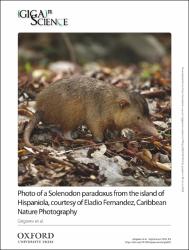| Sinopsis: | Solenodons are insectivores that live in Hispaniola and Cuba. They form an isolated branch in the tree of placental mammals that are highly divergent from other eulipothyplan insectivores The history, unique biology, and adaptations of these enigmatic venomous species could be illuminated by the availability of genome data. However, a whole genome assembly for solenodons has not been previously performed, partially due to the difficulty in obtaining samples from the field. Island isolation and reduced numbers have likely resulted in high homozygosity within the Hispaniolan solenodon (Solenodon paradoxus). Thus, we tested the performance of several assembly strategies on the genome of this genetically impoverished species.
|
| Autor(es): | Grigorev, Kirill
Kliver, Sergey
Dobrynin, Pavel
Komissarov, Aleksey
Wolfsberger, Walter
Krasheninnikova, Ksenia
Afanador-Hernández, Yashira M.
Brandt, Adam L.
Paulino, Liz A.
Carreras de León, Rosanna
Rodríguez, Luis E.
Nuñez, Adrell
Brandt, Jessica R.
Silva, Filipe
Hernández-Martich, David
Majeske1, Audrey J.
Antunes, Agostinho
Roca, Alfred L.
O’Brien, Stephen J.
Martínez-Cruzado, Juan Carlos
Oleksyk, Taras K.
|
| Año: | 2018
|
| Publicado: | GigaScience [ISSN: 2047-217X], 7(6), giy025
|
| Citación: | Grigorev, K., Kliver, S., Dobrynin, P., Komissarov, A., Wolfsberger, W., Krasheninnikova, K., ... & Oleksyk, T. K. (2018). Innovative assembly strategy contributes to understanding the evolution and conservation genetics of the endangered Solenodon paradoxus from the island of Hispaniola. GigaScience, 7(6), giy025. Recuperado de:
|
| URI: | https://bvearmb.do/handle/123456789/1056
|


